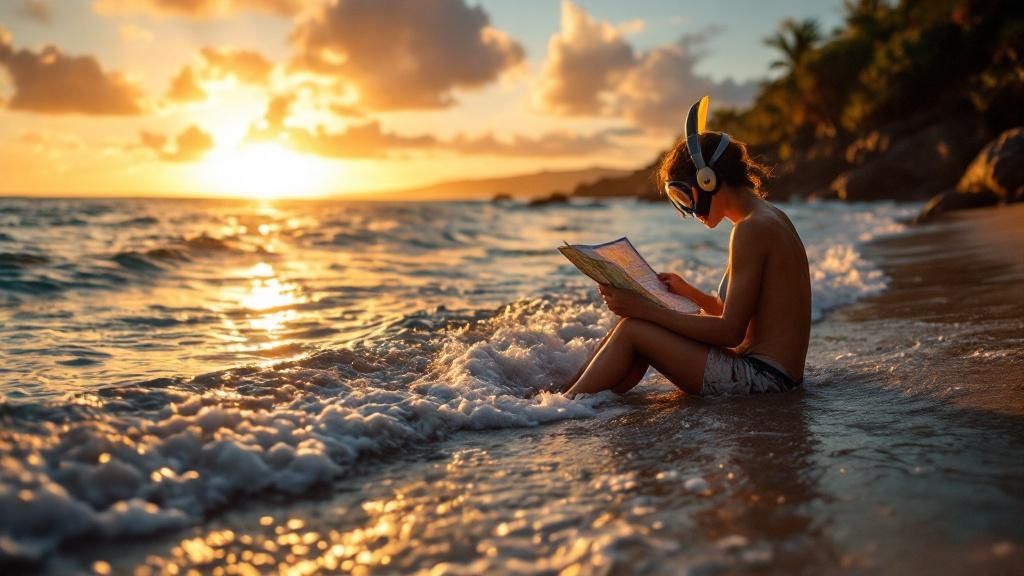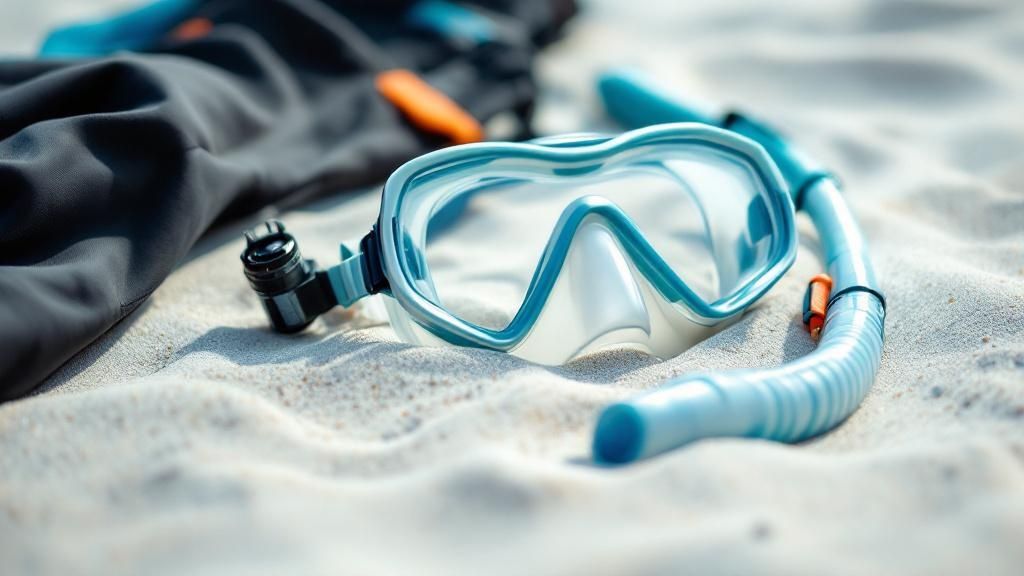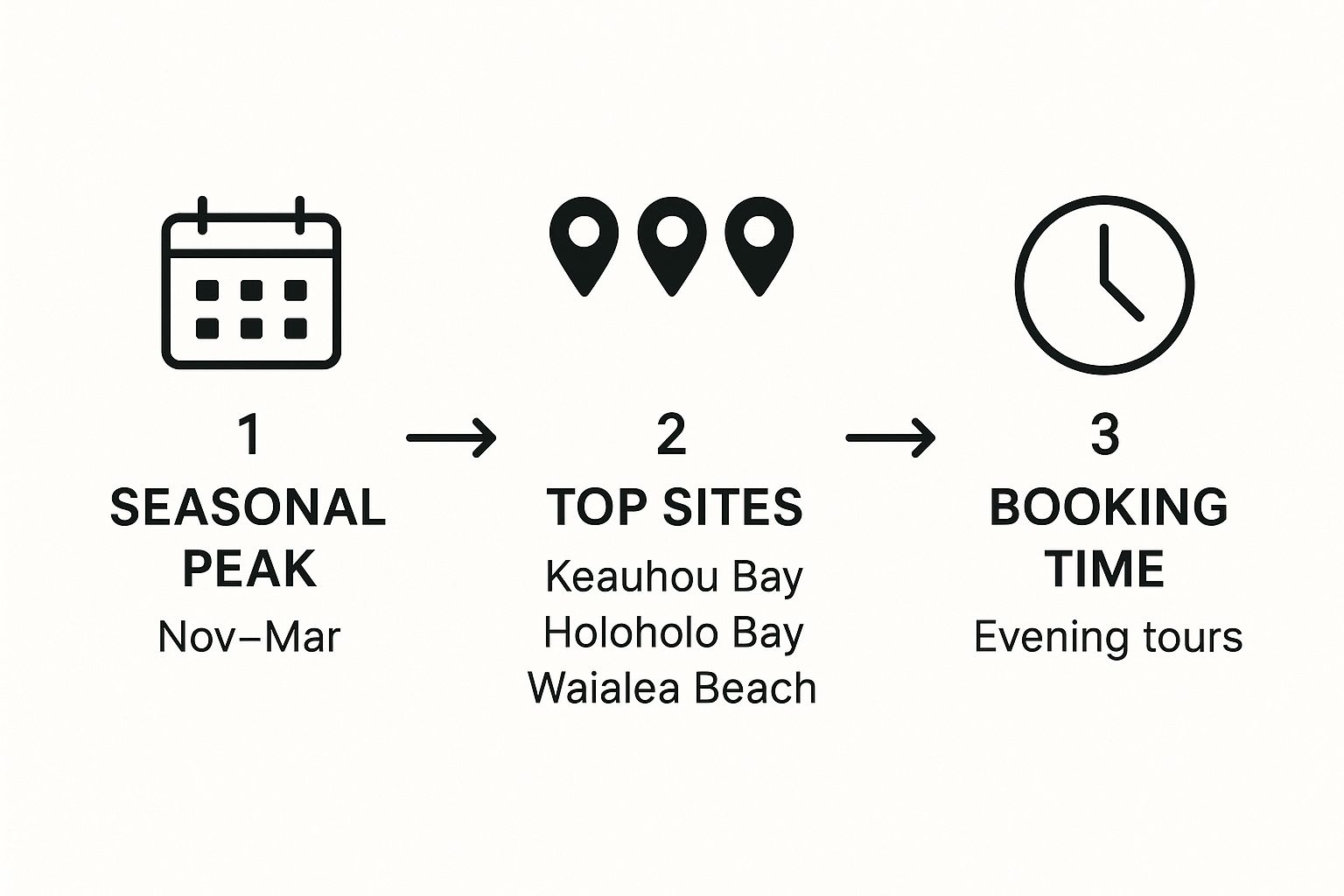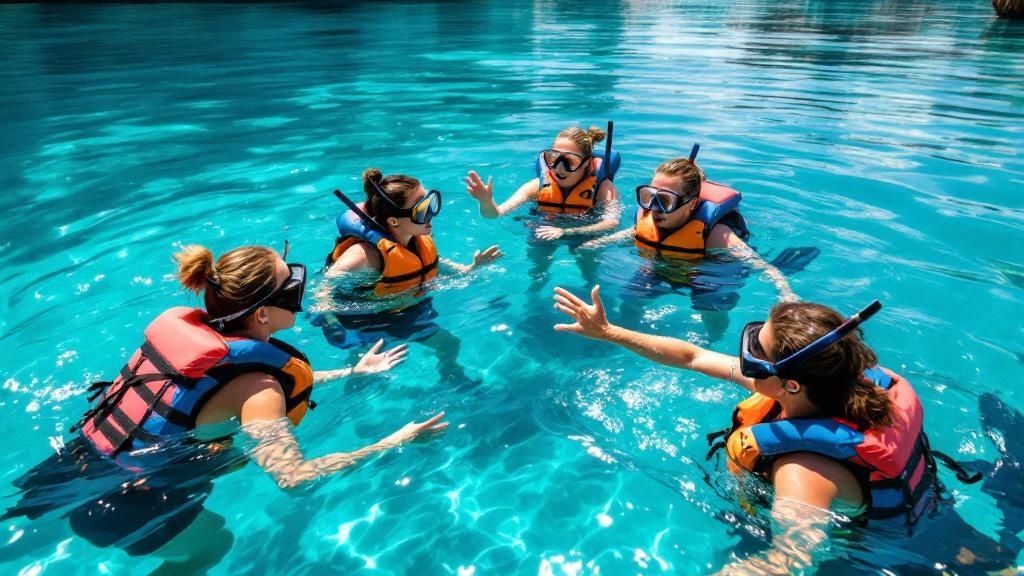Manta Ray Snorkel Big Island: Experience the Magic
- Byron
- Jul 13
- 14 min read
Picture this: you're floating in the calm, dark ocean off the Big Island of Hawaii. Just inches beneath you, giant, gentle manta rays glide and dance through beams of light. This isn't a scene from a nature documentary—it's the world-famous manta ray night snorkel on the Big Island, and it’s an experience you’ll never forget.
This guide is your key to unlocking that magic for yourself. For the ultimate adventure, consider a tour with Manta Ray Night Snorkel Hawaii.
Witnessing the Manta Ray Ballet in Kona
Here at Manta Ray Night Snorkel Hawaii, we live and breathe this adventure. But don't just take our word for it—see what it's like through the eyes of people who were right where you are, planning their own trip.

Why Kona Is the Best Place on Earth for Manta Encounters
There's a reason the Kona coast is considered the world's #1 spot for this activity. It all comes down to what some locals call the "campfire effect."
Our tour boats shine powerful, eco-friendly lights into the water. These lights attract huge clouds of microscopic plankton, which just so happens to be a manta ray's favorite meal. This reliable, floating buffet draws the mantas in for a spectacular feeding show right in front of you. You'll see them gracefully swoop, soar, and barrel-roll through the light beams, filtering the plankton from the water. It’s this nightly feast that gives us such a consistently high sighting success rate.
But this experience is so much more than just an amazing tour. It’s a cornerstone of the local ecosystem and economy. Manta ray tourism is a powerful force for marine conservation on the island. Every year, around 80,000 people join these tours, lured by the incredible 80-90% sighting success rate. Many of us operators reinvest a portion of that directly into research and conservation efforts to protect these incredible animals. You can learn more about how your tour helps in our complete Hawaii adventure guide.
This model of sustainable tourism builds a crucial bridge between local businesses, scientists, and conservationists. It’s a partnership that helps ensure the Kona manta rays will be thriving for generations to come.
Ready to book your front-row seat for this incredible underwater ballet?
In the rest of this guide, we'll walk you through everything you need to know to feel prepared, confident, and unbelievably excited for an adventure that will truly stay with you forever.
How to Choose Your Manta Ray Snorkel Tour
Picking the right manta ray snorkel Big Island tour is easily the most important decision you'll make. It’s the one thing that will shape your entire memory of this incredible night. Trust me, not all operators are the same, and knowing the key differences will help you find the perfect fit for your group, comfort level, and budget.
Here at Manta Ray Night Snorkel Hawaii, we’ve seen countless times how a well-chosen tour turns into a magical, once-in-a-lifetime experience. But before you click "book," let's break down the options so you can make the best choice.

Comparing the Two Main Snorkel Locations
On the Big Island, tour operators focus on two main manta feeding sites. Where you go can make a big difference in your experience.
Manta Village (Keauhou Bay): This is the classic, original viewing site just south of Kailua-Kona. It’s famous for its consistency, boasting a success rate that’s often over 95%. The bay is pretty sheltered, which usually means calmer waters. The biggest plus? Some boats leave right from Keauhou Harbor, so your boat ride can be just a few minutes long.
Manta Heaven (Garden Eel Cove): You'll find this spot north of Kona, closer to the airport. It's another fantastic site, and while the sighting rate is a hair lower (still an incredible 90%), Manta Heaven is known for drawing in huge numbers of rays on a good night. The trade-off is a longer boat ride from Honokohau Harbor, usually about 30-45 minutes each way.
So, which one should you pick? It really comes down to a choice between reliability and spectacle. Manta Village is a sure bet with a short boat ride, perfect for anyone worried about seasickness. Manta Heaven, on the other hand, offers the potential for a bigger show but involves more time on the open ocean.
Small Boat vs. Large Vessel: What's Your Style?
The size of your boat and tour group completely changes the vibe of the trip. There's no right answer here, just what feels right for you.
Large Catamarans: These bigger boats offer a much more stable ride, have more room to walk around, and often come with amenities like an onboard restroom. They are an excellent choice for families with kids or anyone who just wants a smoother, more comfortable journey.
Small Group Zodiacs: These tours use smaller, faster boats, almost like the ones the Navy uses. The ride itself is part of the adventure—it can be fast, bumpy, and a lot of fun. With way fewer people (often 15 or less), the experience in the water feels much more personal and intimate.
Key Takeaway: If you're looking for comfort, stability, and amenities, a larger boat is the way to go. If you want a little more thrill and a small-group feel, a Zodiac tour is an awesome choice.
Signs of a Reputable and Ethical Operator
The company you choose has a direct impact on the well-being of the manta rays. A responsible operator doesn't just give you a great night; they actively protect the animals and their home. For a full rundown on what to look for, check out our [ultimate guide and tips for your Manta Ray Snorkel](https://www.mantaraynightsnorkelhawaii.com/post/manta-ray-snorkel-big-island-ultimate-guide-tips-1).
Before you book with anyone, be sure to ask these questions:
What's your guide-to-guest ratio? A smaller group per guide means better safety and more personal attention.
Are your guides lifeguard certified? Safety should always be the number one priority.
What are your manta viewing rules? They should be very strict about a "look, don't touch" policy. This protects the mantas' delicate skin.
What happens if no mantas show up? Good companies typically offer a "manta guarantee," meaning you can come back another night for free.
Choosing wisely doesn't just guarantee you an amazing adventure; it also helps protect these magnificent creatures for years to come.
How to Prepare for Your Night Snorkel Adventure
A little bit of prep work goes a long way toward making your manta ray snorkel a truly mind-blowing experience. When you know what to expect and what to bring, you can skip the stress and just soak in the magic of the evening.
The great news is that you don’t need to worry about the specialized gear. Top-notch operators like Manta Ray Night Snorkel Hawaii have you covered with high-quality wetsuits, masks, snorkels, and flotation devices. Your job is just to bring the essentials for your own comfort.
What to Pack in Your Bag
Packing for this trip is all about being smart and light. You really only need a few things to stay comfortable before and after your time in the water. That boat ride back to the marina can feel a little brisk after a swim, even in warm Hawaiian weather, so a dry change of clothes is key.
Here’s a quick rundown of what you should tuck into your bag:
Swimsuit: The easiest approach is to just wear it under your clothes when you head to the boat.
Towel: A quick-drying microfiber towel is perfect. They’re super absorbent but don’t take up much space.
A Dry Change of Clothes: Think cozy. A warm hoodie or long-sleeve shirt and some comfy pants will feel amazing on the ride back to shore.
Personal Medications: Don't forget any necessary medications. If you’re prone to motion sickness, it's wise to bring your preferred remedy and take it before you board.
Expert Tip: Want to shake off those pre-tour nerves? Check out our first-timer's guide to the manta ray snorkel for extra tips and insights that will have you feeling like a pro.
To make packing even simpler, here's a quick checklist breaking down what you'll handle versus what the tour company typically provides.
What to Bring vs What Your Tour Provides
Use this checklist to pack efficiently for your manta ray snorkel adventure.
Item | What You Should Bring | What Your Tour Typically Provides |
|---|---|---|
Swimsuit | ✅ Yes, wear it to the tour | ❌ No |
Towel | ✅ Yes, a quick-dry one is best | ❌ No |
Dry Clothes | ✅ Yes, something warm | ❌ No |
Wetsuit | ❌ No | ✅ Yes, for warmth & buoyancy |
Snorkel Mask & Snorkel | ❌ No | ✅ Yes, professional grade |
Flotation Device | ❌ No | ✅ Yes, a custom light board |
Reef-Safe Sunscreen | ✅ Yes, mineral-based | ❌ No |
Motion Sickness Meds | ✅ Yes, if needed | ❌ No |
Waterproof Camera | ✅ Yes, if you want your own shots | ❌ No (some offer photo packages) |
Snacks & Drinks | ❌ No | ✅ Yes, usually water and light snacks |
Having your bag packed with these few essentials ensures you'll be comfortable from start to finish, letting you focus entirely on the incredible experience ahead.
The Importance of Reef-Safe Sunscreen
Even though this is a night tour, the boat often heads out while the sun is still setting. Protecting both your skin and Hawaii's fragile marine life is crucial. This is where reef-safe sunscreen comes in.
Standard sunscreens are loaded with chemicals like oxybenzone and octinoxate that are extremely harmful to our coral reefs. These ingredients can cause coral bleaching and poison the delicate ecosystem the mantas rely on.
By choosing a mineral-based sunscreen (look for zinc oxide or titanium dioxide as the active ingredient), you're making a huge difference. It’s a simple switch that helps protect this underwater paradise for years to come. Just be sure to apply it about 20-30 minutes before the tour so it has time to absorb.
This infographic gives a great visual overview of what to consider when planning your trip, from timing to the best viewing locations.

As you can see, planning your tour for the evening at one of the main sites gives you the absolute best shot at an unforgettable encounter.
Building Confidence Before You Go
It’s totally normal to feel a bit anxious before heading out, especially if you aren’t an expert swimmer or the idea of being in the ocean after dark is new to you. But here’s the thing: these tours are built for everyone, regardless of experience level.
You absolutely do not need to be a strong swimmer. You'll spend the entire time holding onto a large, stable, custom-built light board that floats on the surface. Seriously, your only job is to float and watch the show below. The wetsuit they provide also makes you incredibly buoyant, so you’ll float with very little effort.
If you’re still feeling a little nervous, here are a few things that can help:
Talk to Your Guides: Don't be shy! Let your guides know you're feeling a bit apprehensive. They are highly-trained professionals whose top priority is your safety and comfort.
Practice Makes Perfect: If you get a chance, try on a snorkel mask in a swimming pool or at a calm beach. Just getting used to breathing through the snorkel can make a world of difference.
Focus on Your Breath: Once you're in the water, take slow, deep, and steady breaths. It’s a simple trick that works wonders for calming your nerves and allows you to be fully present for the incredible sight of the manta rays.
Showing up prepared and feeling confident is the final step. Now, you’re ready for an evening of pure wonder you’ll never forget.
What a Manta Ray Encounter Actually Feels Like
Imagining a manta ray snorkel on the Big Island is one thing. Actually being in the water with them? That’s something else entirely. It's a full-on sensory experience that kicks in long before you even catch a glimpse of a manta. Let’s walk through what this adventure really feels like, from stepping onto the boat to the moment that will be imprinted in your memory forever.

It all starts with a beautiful boat ride along the famous Kona coast. As the sun dips toward the horizon, it paints the sky and water with brilliant oranges, pinks, and purples. This isn’t just a commute to the snorkel spot; it's the opening act. The gentle sway of the boat and the salty air create an incredible feeling of peace and excitement.
Entering the Underwater Theater
Once you arrive, your guides get you all geared up. The first sensation is often the cool, refreshing embrace of the Pacific as you slip into the water. Your wetsuit does its job perfectly, and that initial chill vanishes almost instantly.
From there, you’ll swim a short distance to a custom-made floating light board. You’ll grab onto the handles, becoming part of a human raft floating comfortably on the surface. This board is the secret to the whole experience—it shoots powerful beams of light down into the dark water, creating a brightly lit stage for the main event.
Almost immediately, that light starts attracting microscopic plankton, the manta rays' favorite meal. At first, you'll just see tiny specks swirling in the light beams, like an underwater snowstorm. This is the dinner bell ringing.
It’s a surreal feeling—floating in the quiet darkness, surrounded by the vastness of the ocean, just waiting. The world above disappears, and your entire focus narrows to that glowing patch of water right beneath you.
The silence is almost mesmerizing. All you’ll hear is the gentle lap of water against the float, the sound of your own steady breathing through the snorkel, and the muffled excitement from the others around you. And then, it happens.
The Graceful Arrival of Giants
Out of the deep, a dark, majestic shape emerges, gliding effortlessly into the light. That first sighting is a moment of pure, jaw-dropping astonishment. These gentle giants, with wingspans that can stretch up to 16 feet, are even more massive and graceful in person than you could ever imagine.
They don't just swim; they perform an underwater ballet. You’ll watch them swoop, glide, and do breathtaking barrel rolls just inches below your body. They turn somersaults with unbelievable agility, their giant mouths open to filter the plankton from the water. It’s a completely silent, beautiful dance.
The success rate is one of the most incredible parts of this adventure. Tour operators report an amazing 85-90% success rate for manta sightings on the Kona coast. This consistency is thanks to the unique conditions of our feeding sites, which are reliable hotspots for plankton. Our ultimate guide for unforgettable encounters goes into even more detail on why this spot is so special.
One of the most profound sensations is just how close they get. A manta might glide right under you, its back so close you feel like you could reach out and touch it (but you absolutely must not!). It’s a peaceful, humbling, and powerful connection with a creature of incredible scale and gentleness.
This experience is so much more than just watching wildlife. It’s a moment of true connection with the natural world.
Guidelines for a Safe and Eco-Friendly Snorkel
Taking part in a manta ray snorkel on the Big Island is more than just a tour; it's an incredible privilege. It also comes with a real responsibility to protect these gentle, majestic animals and their fragile marine home. Following a few key guidelines ensures every trip is safe for us and, most importantly, respectful to the manta rays.
The Golden Rule of Manta Interaction
If you remember just one thing from your briefing, make it this: Look, but do not touch. This is the absolute cornerstone of an ethical and safe manta encounter. It might be tempting, but it’s critical to resist.
Manta rays have a thin, protective mucus layer covering their bodies. Think of it as their immune system—it's their first line of defense against harmful bacteria and infections in the ocean. Touching a manta, even for a second, can strip away this vital coating and leave them vulnerable to disease.
Your guides will be crystal clear about this rule. The whole idea is to be a passive observer. You'll hold onto the light board and just float, becoming part of the scenery as they perform their incredible feeding ballet right below you.
Trust Your Guides and the Process
Your guides aren’t just boat captains; they are highly trained professionals, often with lifeguard certifications, and their number one job is keeping both you and the rays safe. Before you even dip a toe in the water, they'll give you a thorough briefing, explaining all the rules and what to expect.
Listen carefully to your guides' instructions. They know these mantas and the local conditions better than anyone. Following their lead is the surest way to have a fantastic and safe experience.
They'll show you exactly how to get in and out of the water safely, how to position yourself at the light board, and what to do if a manta gets surprisingly close. Their expertise is your best asset for a smooth, worry-free adventure. For any activity on the water, it's always good practice to have a basic understanding of what goes into a comprehensive boat safety checklist to appreciate the safety principles at play.
How Your Tour Supports Manta Conservation
Here's the best part: when you choose a responsible tour operator for your manta ray snorkel on the Big Island, you're doing more than just booking a fun night out. You're actively contributing to conservation. The local industry works hand-in-hand with researchers to protect Kona’s resident manta ray population.
This collaboration has led to some amazing long-term monitoring. For instance, detailed studies track individual manta rays every single night at key sites like "Manta Village" and "Manta Heaven." This careful documentation helps scientists understand their behavior, health, and habitat needs, which is vital for both sustainable tourism and real conservation work.
By coming on a tour, you become part of this positive cycle, helping ensure these amazing creatures continue to thrive for years to come. For a deeper dive into what makes this adventure so special, check out our night adventure guide for the manta ray snorkel.
Ready to be part of this amazing, eco-conscious adventure?
Common Questions About the Manta Snorkel Experience
As you get closer to booking what could be the highlight of your entire Hawaiian vacation, it’s natural for a few questions to come to mind. Venturing out into the ocean at night for a close encounter with giant sea creatures is a pretty unique adventure, after all!
We get it. Based on years of leading manta ray snorkel Big Island tours, we've heard just about every question in the book. Our goal is to clear up any uncertainties so you can feel 100% excited and ready when you book your trip with Manta Ray Night Snorkel Hawaii.
Is the Manta Ray Snorkel Safe for Beginners?
This is easily the most common question we get, and the answer is a huge, resounding yes. Reputable tour operators have designed this experience from the ground up to be safe and accessible for everyone, no matter your swimming level or snorkeling history.
You'll be outfitted with everything you need. A snug wetsuit keeps you warm and adds a surprising amount of buoyancy, making it effortless to float. You'll also spend your time in the water holding onto a large, custom-made light board that floats on the surface.
You definitely don't need to be a strong swimmer. Your only job is to relax, float, and watch the incredible ballet unfold just inches beneath you. Plus, certified guides are in the water with you the entire time, keeping a close eye on everyone to make sure you're safe, comfortable, and having the time of your life.
What Are the Chances of Seeing Manta Rays?
The Kona coast is world-famous for a reason—the odds of seeing manta rays here are incredibly high. Most established tour operators have a success rate that consistently lands between 85% and 90%.
It’s important to remember these are wild animals, so a sighting can never be 100% guaranteed. However, the specific snorkel sites are reliable feeding grounds that the mantas have visited for decades. The powerful lights on the snorkel boards create a "campfire effect" that attracts plankton, essentially ringing a dinner bell that the local manta population rarely ignores.
On the off chance the mantas are a no-show, most reputable companies offer a "manta guarantee." This usually means you can come back and try again on another night for free. It’s a great reason to book your tour early in your trip, just in case! For even more detailed answers, check out our in-depth Manta Ray FAQ page.
Can I Bring My Own Camera?
Yes, and you absolutely should! Bringing a waterproof camera like a GoPro is a fantastic way to capture this surreal experience. The photos and videos will be amazing keepsakes for years to come.
Just a couple of simple rules apply to keep both you and the mantas safe. First, make sure your camera is secured with a wrist strap or a floaty handle. You don't want to watch your expensive camera sink into the dark abyss.
The most important rule is to be a passive observer. Never chase, poke, or try to touch a manta ray with your hand, camera, or a selfie stick. Just float and let them control the encounter. Their natural curiosity will often bring them unbelievably close to you anyway.
Is It Safe to Swim With Manta Rays at Night?
This is another common worry, but rest assured, it is completely safe. Manta rays are true gentle giants. Despite being related to stingrays, they have no stinger, no barb, and no teeth.
They are filter feeders, meaning their diet is made up entirely of microscopic plankton. They have zero interest in harming humans. Your professional guides create a secure and supervised environment, so any jitters you might have about being in the ocean after dark will quickly dissolve into pure awe and wonder.
Ready to book your spot for this unforgettable underwater show?
Comments